INTRODUCTION
Leafy vegetables are frequently implicated in foodborne disease outbreaks [1], and an analysis based on data from outbreaks estimated them to be the most common cause of foodborne illness in the United States [Reference Painter2]. Outbreaks attributed to leafy vegetables can result in severe health outcomes and be widespread, affecting residents of multiple states. In 2006, an outbreak of Shiga toxin-producing Escherichia coli (STEC) O157 infections associated with spinach was the deadliest US foodborne disease outbreak attributed to leafy vegetables ever reported, causing nearly 200 laboratory-confirmed illnesses, 100 hospitalizations, and five deaths [Reference Wendel3].
The annual number of produce-associated outbreaks reported has increased since surveillance for foodborne disease outbreaks began in 1973, and the consumption of produce has steadily increased as well [Reference Sivapalasingam4–6]. While leafy vegetables are an important part of a healthy diet, contamination is particularly concerning because they are usually consumed raw with no cooking to kill any pathogens that might be present [7].
We describe characteristics of outbreaks attributed to leafy vegetables during 1973–2012 and explore possible reasons for changes in the number of outbreaks over time.
METHODS
Surveillance data
The Centers for Disease Control and Prevention's (CDC) Foodborne Disease Outbreak Surveillance System (FDOSS) has collected data on foodborne disease outbreaks voluntarily reported by local, state, and territorial health departments since 1973. The surveillance system underwent major enhancements in 1998 with the collection of additional information and transition to electronic reporting [Reference Gould8]. In 2009, FDOSS transitioned to a new reporting form and electronic reporting system, which receives reports of both foodborne and non-foodborne enteric disease outbreaks [Reference Hall9].
Leafy vegetable outbreaks
We defined a leafy vegetable-associated outbreak as an event in which two or more persons became ill due to the ingestion of a common leafy vegetable food item. We defined a leafy vegetable food item as any vegetable composed of edible leaves, including cabbage, chard, collard greens, ferns, green onions, kale, leeks, lettuce, mustard greens, spinach, and turnip greens. We defined two types of leafy vegetable outbreaks: simple leafy vegetable outbreaks were defined as those in which one or more types of leafy vegetable were implicated. Leafy vegetable-based salad outbreaks were defined as those in which a salad (e.g. house salad or garden salad) was implicated but the specific leafy vegetable causing the outbreak was not reported, and neither beef, eggs, poultry, nor seafood were listed as ingredients. The leafy vegetables were assumed to be uncooked unless otherwise indicated. Reports that indicated that the food was cooked (e.g. boiled spinach) and reports of outbreaks caused by botulinum toxin were excluded from the analysis.
Consumption data
As a proxy for leafy vegetable consumption, we reviewed the leafy vegetable loss-adjusted per capita availability data for 1973–2011 from the US Department of Agriculture (USDA) Economic Research Service [10]. The loss-adjusted per capita availability represents the edible amount of food, post-harvest, that is available for human consumption but is not consumed, and is calculated as the annual farm production and import of leafy vegetables minus spoilage and waste. The following vegetables were included in the calculation for leafy vegetable loss-adjusted per capita availability: cabbage, head lettuce, romaine or leaf lettuce, and spinach. Only data on fresh vegetables that were not canned or frozen and only those leafy vegetable types that were implicated in an outbreak in this analysis were used.
Analysis
We reviewed characteristics of foodborne disease outbreaks reported during 1973–2012 where a leafy vegetable was reported as the implicated food. To account for changes in the surveillance system, some measures were analysed separately for the pre-electronic (1973–1997) and electronic (1998–2012) reporting periods. The outbreak reports included aggregate information on the outbreak, including the number of illnesses, hospitalizations, and deaths, implicated food, location of food preparation, and aetiological agent. Outbreak seasonality was defined as spring (March–May), summer (June–August), autumn (September–November), and winter (December–February). Population-based rates of reported leafy vegetable-associated outbreaks were calculated for each state and year using the US Census estimates of state populations [11].
An outbreak was considered to have a confirmed aetiology if specific confirmation criteria were met [12]; outbreaks that did not meet the confirmation criteria but with sufficient evidence to suspect an aetiology were considered to have a suspected aetiology. Otherwise, the aetiology was reported as unknown. Locations of food preparation were analysed in the following categories: restaurant or catering facility (reported as ‘restaurant or deli’, ‘banquet facility’, ‘wedding reception’, ‘caterer’); institution (‘camp’, ‘day care centre’, ‘hospital’, ‘nursing home’, ‘prison or jail’, ‘school’, ‘workplace cafeteria’); private home or setting (‘church or temple’, ‘office setting’, ‘picnic’, ‘private home’, ‘workplace other than cafeteria’); retail establishment (‘commercial products served without further preparation’, ‘contaminated food imported into the US’, ‘grocery store’); and other (all other settings). Outbreaks associated with multiple food preparation locations were not included in the analysis by location. Information on whether an ill foodworker was implicated, the level of evidence implicating a food, the types of specimens the pathogen was isolated from, and patients' age and sex distributions were collected during 1998–2012. Age groups were collected as proportions of outbreak-associated illnesses and categorized as ‘child’ (<1, 1–4, 5–19 years) and ‘adult’ (20–49, ⩾50 years).
Characteristics of leafy vegetable-associated outbreaks were compared with those of outbreaks attributed to other food vehicles during the same period. A Mann–Whitney Wilcoxon test was used to compare the median outbreak size, and Pearson's χ 2 test was used to compare age, sex, and preparation locations. The relationship between the number of leafy vegetable-associated outbreaks and leafy vegetable loss-adjusted per capita availability was examined using regression of least squares. All data analyses were performed using SAS v. 9.3 (SAS Institute Inc., USA).
RESULTS
Of 12 714 foodborne disease outbreaks with at least one food item implicated during 1973–2012, 606 (5%) had a leafy vegetable implicated (162 outbreaks with a simple leafy vegetable as the vehicle and 444 outbreaks with a leafy vegetable-based salad as the vehicle), resulting in 20 003 illnesses, 1030 hospitalizations, and 19 deaths. The median proportion of outbreaks attributed to raw leafy vegetables each year was 3% (range 0–12%). The annual number of outbreaks associated with leafy vegetables increased from a median of 4 (2% of outbreaks with a food implicated) during 1973–1997 (pre-electronic reporting) (range 0–15 per year) to a median of 37 (5%) during 1998–2012 (electronic reporting) (range 14–49), but the median number of ill persons per outbreak markedly decreased (Fig. 1).
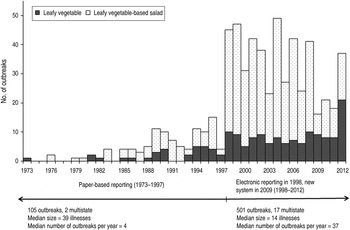
Fig. 1. Number of reported leafy vegetable-associated outbreaks, including simple leafy vegetables and leafy vegetable-based salads, United States, 1973–2012.
A single confirmed or suspected aetiology was reported for 396 (65%) outbreaks; three had multiple aetiologies, and the remainder had an unknown aetiology (Table 1). Of the 272 (69%) confirmed single aetiology outbreaks reported, norovirus was the most common, followed by STEC, and Salmonella. During 1973–1997, 6% of outbreaks were confirmed as caused by norovirus, and 65% had an unknown aetiology. Conversely, during 1998–2012, 29% of outbreaks were confirmed as caused by norovirus and 28% by an unknown aetiology. STEC serogroups that caused outbreaks were O157 (45 outbreaks, 94% of confirmed STEC outbreaks), O145 (two, 4%), and O121 (one, 2%). In outbreaks confirmed as caused by Salmonella, 13 known serotypes were reported; serotypes Enteritidis and Typhimurium were the most frequently reported (seven and six outbreaks, respectively, 45% of total). Outbreaks caused by STEC had the highest proportion of persons hospitalized (46%), followed by those caused by hepatitis A (22%), and Shigella (12%). Nine deaths occurred in outbreaks caused by hepatitis A (transmitted by lettuce to five persons, by green onions to three, by coleslaw to one), nine in outbreaks caused by STEC (transmitted by spinach to six persons, by lettuce to two, and salad to two), and one in an outbreak caused by norovirus (transmitted by salad).
Table 1. Leafy vegetable-associated outbreaks, illnesses, hospitalizations, and deaths associated with a single aetiology, United States, 1973–2012
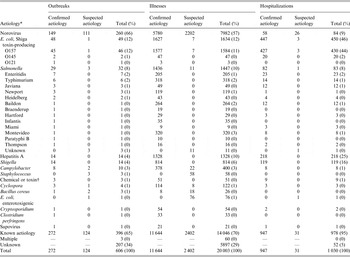
* Laboratory and clinical guidelines for confirming an aetiology of a foodborne disease outbreak are specific for each bacterial, chemical/toxin, parasitic, and viral agent. Suspected aetiologies are those that do not meet the confirmation guidelines (available at http://www.cdc.gov/foodsafety/outbreaks/investigating-outbreaks/confirming_diagnosis.html).
† Jimson weed (one outbreak, six illnesses), methomyl (one outbreak, 31 illnesses), aldicarb (one outbreak, 14 illnesses).
Of the 97 outbreaks caused by simple leafy vegetables with a confirmed single aetiology, STEC was the most common (37 outbreaks, 38%), followed by norovirus (28, 29%), Salmonella (10, 10%), and hepatitis A (eight, 8%) (Table 2). Of the 175 outbreaks caused by leafy-based salads with a confirmed single aetiology, norovirus was the most common (121 outbreaks, 69%), followed by Salmonella (19, 11%), STEC (11, 6%), and Shigella (11, 6%).
Table 2. Leafy vegetable-associated outbreaks by food type and aetiology (n = 606), United States, 1973–2012
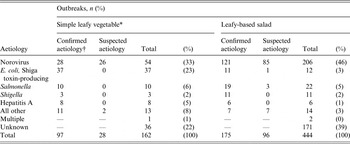
* Includes lettuce (120 outbreaks), unspecified leafy (14 outbreaks), cabbage (nine outbreaks), green onions (eight outbreaks), ferns (six outbreaks), and spinach (five outbreaks).
† Laboratory and clinical guidelines for confirming an aetiology of a foodborne disease outbreak are specific for each bacterial, chemical/toxin, parasitic, and viral agent. Suspected aetiologies are those that do not meet the confirmation guidelines (available at http://www.cdc.gov/foodsafety/outbreaks/investigating-outbreaks/confirming_diagnosis.html).
Leafy vegetable-associated outbreaks were reported by 44 states and Puerto Rico. For the 580 outbreaks where the exposure occurred in a single state, the average state-specific reporting rate was 0·06/1 000 000 population (range 0·01–0·21). Minnesota had the highest average annual rate of reported leafy vegetable-associated outbreaks (0·21), followed by Washington (0·20), and Oregon (0·17).
Twenty-six (4%) outbreaks (24 associated with simple leafy vegetables, one with multiple simple leafy vegetables, and one with a leafy vegetable-based salad) were multistate (i.e. exposure to the implicated food occurred in more than one state). STEC was the most common aetiology (18 outbreaks, 69%), followed by Salmonella (six outbreaks, 23%). Leafy vegetables implicated in multistate outbreaks were lettuce (18 outbreaks, 69%), green onions (three, 12%), spinach (two, 8%), lettuce and spinach (one, 4%), unspecified leafy (one, 4%), and pre-packed leafy vegetable-based salad (one, 4%).
Reported outbreaks occurred most frequently during spring (31%). Outbreaks caused by norovirus were most common in all seasons, and by pathogen seasonality varied. Norovirus outbreaks peaked during winter (35% of norovirus outbreaks), STEC peaked in autumn (51%), and Salmonella in summer (38%) and spring (31%) (Fig. 2).
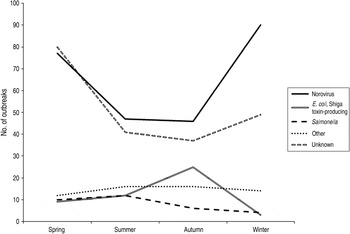
Fig. 2. Number of reported leafy vegetable-associated outbreaks by season when the outbreak began and aetiology, United States, 1973–2012. [Season: spring (March–May), summer (June–August), autumn (September–November), winter (December–February).]
Of the 162 (27%) outbreaks due to a simple leafy vegetable, most were attributed to lettuce (120, 74%). Other leafy vegetables implicated were cabbage (nine outbreaks, 6%), green onions (eight, 5%), ferns (six, 4%), and spinach (five, 3%). Of the 50 (42%) outbreaks in which a specific type of lettuce was implicated, the types were romaine (15, 30%), iceberg (13 outbreaks, 26%), leaf (12, 24%), mesclun mix (nine, 18%), and arugula (one, 2%). Of the 97 outbreaks with a confirmed aetiology due to a simple food leafy vegetable, the food-aetiology pair implicated most often was lettuce and STEC (29 outbreaks, 30%), followed by lettuce and norovirus (24, 25%). However, when outbreaks with suspected aetiologies were included, the food-aetiology pair implicated most often was lettuce and norovirus.
Of the 444 outbreaks caused by leafy vegetable-based salads, the types were listed as salad (125, 28%), lettuce-based (99, 22%), green or garden (71, 16%), house (41, 9%), coleslaw (41, 9%), Caesar (34, 8%), tossed (17, 4%), multiple (nine, 2%), pre-packaged (three, 1%), spring (three, 1%), and spinach (one, <1%). Of the 175 outbreaks attributed to a leafy vegetable-based salad with a single confirmed aetiology, most were caused by norovirus (121 outbreaks, 69%), followed by Salmonella (19 outbreaks, 11%), Shigella (11, 6%), and STEC (11, 6%).
In the 501 outbreaks reported during 1998–2012, the level of evidence implicating a leafy vegetable was reported for 389 (78%). Epidemiological or laboratory evidence was used to implicate the food for 72 (65%) simple food leafy vegetable outbreaks and 167 (60%) leafy vegetable-based salad outbreaks. In outbreaks where the food was implicated based on other types of evidence (e.g. supportive information) and caused by a single confirmed aetiology, norovirus was reported for 47% of outbreaks caused by a simple food leafy vegetable and 77% caused by a leafy vegetable-based salad. Of the 138 confirmed norovirus outbreaks reported during 1998–2012, norovirus was isolated from a patient specimen in 101 (73%), from patient and foodworker specimens in 36 (26%), and from patient specimens and food in one (1%).
Information on the suspected or confirmed point where the leafy vegetables were contaminated was collected starting in 2009. Of the 52 outbreaks with information, contamination was reported at the point of preparation for 39 (75%) and before preparation for 13 (25%). For three outbreaks with contamination reported before preparation, contamination at harvest was reported; for the remainder the point of contamination was not reported. Information on point of contamination was provided for 19 norovirus outbreaks; in all 19, contamination was reported at the point of preparation.
A preparation location was reported for 579 (96%) leafy vegetable-associated outbreaks, and, of these, 557 (96%) implicated a single location (Table 3). Of outbreaks with a single preparation location, 75% of outbreaks associated with a simple leafy vegetable and 88% of outbreaks associated with a leafy-based salad were attributed to foods prepared in a restaurant or catering facility, compared to 7083/11 142 (64%) outbreaks with another food vehicle implicated (P < 0·001). In addition, in outbreaks attributed to leafy vegetables prepared in a restaurant or catering facility and a single confirmed aetiology, 61% were caused by norovirus. The second most commonly implicated aetiology and preparation location pairing was STEC and a restaurant or catering facility (12%). Although only four (2%) confirmed aetiology outbreaks implicated a food prepared in a retail setting, three were caused by STEC. An ill foodworker was implicated in 155 (31%) leafy vegetable-associated outbreaks (27 simple leafy vegetable, 128 leafy vegetable-based salads) compared to only 12% of all other outbreaks with an implicated food (P < 0·001). Of the 90 leafy vegetable-associated outbreaks with a single confirmed aetiology that implicated an ill food-worker, 75 (84%; 14 simple leafy vegetable, 61 leafy vegetable-based salads) were caused by norovirus.
Table 3. Leafy vegetable-associated outbreaks by food type and single location of food preparation location (n = 557), United States, 1973–2012
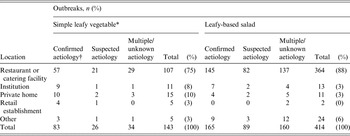
* Includes lettuce (120 outbreaks), unspecified leafy (14 outbreaks), cabbage (nine outbreaks), green onions (eight outbreaks), ferns (six outbreaks), and spinach (five outbreaks).
† Laboratory and clinical guidelines for confirming an aetiology of a foodborne disease outbreak are specific for each bacterial, chemical/toxin, parasitic, and viral agent. Suspected aetiologies are those that do not meet the confirmation guidelines (available at http://www.cdc.gov/foodsafety/outbreaks/investigating-outbreaks/confirming_diagnosis.html).
Compared to illnesses in outbreaks attributed to other foods, illnesses in leafy vegetable-associated outbreaks were more common in adults (85% vs. 77%, P < 0·001) and in women (59% vs. 50%, P < 0·001). In addition, the median size of leafy vegetable outbreaks was larger than outbreaks attributed to other foods (17 vs. 9, P < 0·001).
We compared the number of outbreaks attributed to a leafy vegetable with the annual leafy vegetable consumption per capita during 1973–2011. The annual leafy vegetable consumption was a poor predictor of the number of leafy vegetable-associated outbreaks during 1973–1997 (R 2 = 0·37, P = 0·001) and during 1998–2011 (R 2 = 0·34, P = 0·029). In particular, lettuce and spinach consumption were poor predictors for lettuce and spinach-associated outbreaks during 1973–2011 (R 2 = 0·14, P < 0·017) and (R 2 = 0·15, P = 0·016), respectively.
DISCUSSION
Leafy vegetables, an important part of a healthy diet, were implicated in many foodborne disease outbreaks. In outbreaks with a confirmed or suspected aetiology, norovirus caused over half; it was by far the most common confirmed or suspected cause of leafy vegetable-based salad outbreaks and was the second most common cause of simple leafy vegetable outbreaks with a confirmed aetiology. The large percentage of outbreaks in which the leafy vegetable food was prepared in a restaurant and contaminated with norovirus, often by an ill food worker, underscores the need to enforce safe handling practices for leafy vegetables and food containing leafy vegetables, like salads, by food workers. Additionally, contamination of leafy vegetables early in production by bacterial pathogens like STEC and Salmonella caused nearly all multistate outbreaks.
Norovirus, the leading cause of foodborne disease outbreaks [Reference Hall13], caused most of the outbreaks associated with leafy vegetables. In an analysis of data from 2001 to 2008, in all foodborne norovirus outbreaks with a single implicated food vehicle, leafy vegetables were most often implicated [Reference Hall13]. Most leafy vegetable-associated norovirus outbreaks involved preparation in a restaurant or catering facility, and ill food workers were often implicated as a source of contamination; this finding is consistent with the epidemiology of all foodborne norovirus outbreaks. Most of these outbreaks likely resulted from contamination at the point of preparation, due to improper hand hygiene [Reference Hall13]. Therefore, proper food handling guidelines for restaurant workers should emphasize the importance of hand hygiene and not preparing food when ill. Contamination during production might also lead to norovirus contamination of leafy vegetables [Reference Hall13, Reference Ethelberg14]. Because the outbreak reports contained limited information on the point where contamination occurred, we were unable to determine whether any outbreaks resulted from contamination during production. Results of laboratory tests for norovirus in the implicated vegetables were infrequently reported; most norovirus outbreaks were attributed to leafy vegetables based on evidence from epidemiological studies or results of testing of ill food workers.
STEC was the leading cause of simple leafy vegetable outbreaks with a confirmed aetiology. In all leafy vegetable outbreaks, STEC caused nearly two-thirds of multistate outbreaks, over 45% of hospitalizations, and nearly half of the deaths. The number of STEC outbreaks attributed to leafy vegetables has increased in recent years. Contamination of leafy vegetables with bacterial pathogens like E. coli and Salmonella can happen at many points in production, but the large number of multistate outbreaks caused by these pathogens suggests contamination early in production. Leafy vegetables can become contaminated with pathogens by water used for irrigation, animal manure used for fertilizer, and feral animals that traverse vegetable fields. Contamination can also occur during processing, including during washing, cutting, and storage [15]. E. coli and Salmonella can be internalized into plant tissues, rendering washing ineffective [16]; bacteria can also adhere to cut surfaces so leafy vegetables should be cleaned thoroughly before cutting. Leafy vegetable contamination on the farm or during processing has the potential to result in particularly large, widespread outbreaks, as evidenced by the three largest leafy-vegetable multistate outbreaks [Reference Wheeler17–19]. Interventions are needed to prevent contamination of leafy vegetables on the farm and to implement improved decontamination methods during processing.
Changes over time in the number of outbreaks attributed to leafy vegetables likely primarily reflect enhancements to foodborne disease outbreak surveillance and investigation. The increased number of leafy vegetable-associated outbreaks caused by norovirus during the second half of this period is consistent with the overall increase in reported foodborne norovirus outbreaks as a result of advancements in laboratory diagnostics for norovirus identification [Reference Widdowson20] and an associated decrease in the proportion of foodborne disease outbreaks with an unknown aetiology [Reference Gould8]. It is likely that many of the unknown aetiology outbreaks during the earlier years of the study period were undiagnosed norovirus outbreaks. This assumption is supported further by the seasonality of unknown aetiology outbreaks, which mirrors that of norovirus leafy vegetable-associated outbreaks seen in this study (Fig. 2). Our finding of a marked increase in leafy vegetable-associated outbreaks beginning in 1998 when the surveillance system became electronic, suggests that the increase was at least partially driven by improvements in outbreak surveillance that facilitated reporting of foodborne disease outbreaks from state and local health departments to CDC [Reference Gould8]. Around the same time, improved outbreak detection for E. coli O157 and Salmonella, through CDC's PulseNet led to an overall increase in the number of bacterial foodborne disease outbreaks reported and increased detection of multistate outbreaks [Reference Swaminathan21].
Changes in leafy vegetable consumption do not fully explain changes in the number of outbreaks over time. Over the past 40 years, leafy vegetable consumption has modestly increased in the United States, from 16 lb per capita in 1973 to 17 lb in 2011, although the types of leafy vegetables available changed. For example, the per capita availability of head lettuce decreased from 20·8 lb per capita in 1973 to 13·2 lb in 2012, while the availability of romaine and leaf lettuce increased from 3 lb per capita in 1985 to 10·7 lb in 2012 [10]. Because some types of lettuce are more likely to be contaminated in the field or during harvest, these changes could have increased the risk of consumer exposure to contaminated leafy greens. Additionally, the availability of bagged salads and other freshly cut produce has increased exponentially since their introduction to the market in the early 1980s [Reference Garrett22], and other changes in packaging, processing, and distribution have extended the shelf life of leafy vegetables to make them more available throughout the year [Reference Beuchat23]. Our finding that lettuce was implicated in 74% of simple leafy vegetable outbreaks of a known type is consistent with the consumption data showing that 75% of leafy vegetables consumed in the United States during this time period were lettuce [10]; however, because few outbreaks reported the type of lettuce or information on processing and packaging, we could not evaluate the impact of these changes on the number of outbreaks.
Implication of leafy vegetables during outbreak investigations can be challenging, requiring substantial resources and public health capacity at the local, state, and federal levels [Reference Hoffman24]. For example, leafy vegetables are often consumed with other foods, such as in a green salad or as a garnish on a sandwich, which could also include other vegetables, cheeses, meats, and dressing. Identifying the contaminated ingredient in a food like a salad can be difficult, requiring detailed information on the component ingredients. Collection of these data is complex and time-consuming, requiring extensive resources for investigation and traceback. Seventy-six percent of the outbreaks in this analysis were attributed to lettuce-based salads but the specific implicated leafy vegetable was unknown, so it is possible that we overestimated the number of leafy vegetable-associated outbreaks as we cannot be certain that the leafy vegetable was the contaminated ingredient. Additionally, detailed information on processing and packaging, such as whether lettuce was bagged or pre-packaged, was provided for only 1% of outbreaks included in this analysis.
Prevention of outbreaks attributed to leafy vegetables requires a multifaceted approach to reduce contamination. In early 2013, the Food and Drug Administration proposed new regulations for the produce industry under the Food Safety Modernization Act [25]. These regulations address a number of important issues, including the quality of water used for produce irrigation and processing, and sanitary facilities for workers. These regulations are an important advance to make leafy vegetables and other produce safer. On-farm control efforts are needed to ensure proper handwashing techniques and to minimize cross-contamination. Because most leafy vegetable-associated outbreaks were caused by norovirus and occurred in restaurants because of handling by ill food workers, further efforts are needed to ensure appropriate food handling practices in restaurants and catering settings. From 2001 to 2012, the now discontinued USDA Agricultural Marketing Service Microbiological Data Program routinely tested select produce samples, including leafy vegetables (lettuce, spinach, and green onions) in 11 states; positive test results were provided to PulseNet for correlation with human illness and product recall data. Renewed surveillance for microbial contamination of leafy vegetables could help to assess the effectiveness of prevention measures.
Only a small proportion of the vast amount of leafy vegetables consumed each year causes illness [Reference Painter2]. To decrease the risk of illness, consumers and food workers should wash leafy vegetables when recommended, wash their hands before and after handling leafy vegetables, and avoid preparing food when they have a diarrhoeal illness.
ACKNOWLEDGEMENTS
We thank state and local health departments for reporting outbreak surveillance data and Patricia Griffin for helpful comments that strengthened the manuscript.
The findings and conclusions are those of the authors and do not necessarily represent those of the Centers for Disease Control and Prevention.
This research received no specific grant from any funding agency, commercial or non-for-profit sectors.
DECLARATION OF INTEREST
None.








